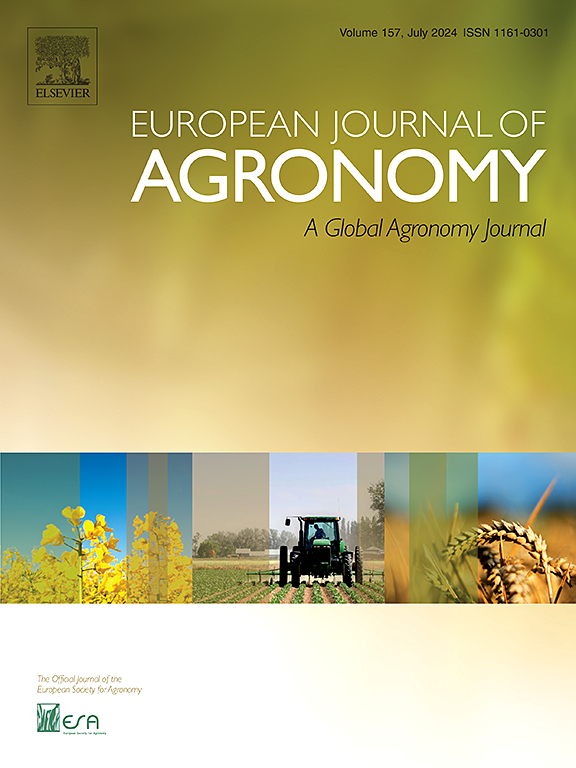气候变化下华北平原冬小麦品种产量和生态系统净生产力优化研究
IF 4.5
1区 农林科学
Q1 AGRONOMY
引用次数: 0
摘要
全球变暖给作物生产带来了重大挑战,但强调未来产量而不是碳封存限制了我们对农田如何影响气候变化的理解。本研究结合世界粮食研究模型和北方生态系统生产力模拟器,评估了未来气候变化下品种优化对华北平原冬小麦产量和净生态系统生产力的影响。在不进行品种优化的情况下,SSP245和SSP585处理的冬小麦产量预计将分别平均下降9.1% %和11.9% %,而NEP处理的产量预计将增加,尤其是SSP585处理。花期和成熟期均提前,营养生长期缩短,生殖生长期保持相对稳定。品种优化后,冬小麦的气候敏感性降低,预估产量在SSP245和SSP585处理下分别平均提高20.7 %和16.9 %,NEP普遍提高。然而,考虑到粮食碳含量,河北和山东的某些地区可能从碳汇向碳源过渡。开花比成熟提前,延长了RGS的持续时间。我们的研究结果强调了物候在调节冬小麦产量和NEP中的关键作用,特别强调了VGS期间气候条件的影响比RGS更强。模型结果表明,未来的品种优化策略应该是减少VGS期间的热量需求,增加RGS期间的热量需求。本文章由计算机程序翻译,如有差异,请以英文原文为准。
Optimizing winter wheat varieties for yield and net ecosystem productivity under climate change in the North China Plain
Global warming presents significant challenges to crop production, but the emphasis on future yields rather than carbon sequestration has limited our understanding of how cropland contributes to climate change. In this study, we integrated the World Food Studies model and the Boreal Ecosystem Productivity Simulator to evaluate the impacts of variety optimization on winter wheat yield and net ecosystem productivity (NEP) in the North China Plain under future climate change. Without variety optimization, winter wheat yield was projected to decline by an average of 9.1 % and 11.9 % under SSP245 and SSP585, respectively, while NEP was expected to increase, particularly under SSP585. Both flowering and maturity dates advanced, shortening the vegetative growth stage (VGS) while maintaining a relatively stable reproductive growth stage (RGS). With variety optimization, winter wheat showed reduced climate sensitivity, with yield projected to increase by an average of 20.7 % and 16.9 % under SSP245 and SSP585, respectively, and NEP generally increased. However, certain regions in Hebei and Shandong may transition from carbon sinks to sources when grain carbon content is considered. Additionally, flowering advanced more significantly than maturity, extending the duration of RGS. Our findings highlight the critical role of phenology in regulating winter wheat yield and NEP, particularly emphasizing the stronger influence of climatic conditions during VGS compared to RGS. Model results suggest future variety optimization strategies should reduce heat requirements during VGS and increase them during RGS.
求助全文
通过发布文献求助,成功后即可免费获取论文全文。
去求助
来源期刊

European Journal of Agronomy
农林科学-农艺学
CiteScore
8.30
自引率
7.70%
发文量
187
审稿时长
4.5 months
期刊介绍:
The European Journal of Agronomy, the official journal of the European Society for Agronomy, publishes original research papers reporting experimental and theoretical contributions to field-based agronomy and crop science. The journal will consider research at the field level for agricultural, horticultural and tree crops, that uses comprehensive and explanatory approaches. The EJA covers the following topics:
crop physiology
crop production and management including irrigation, fertilization and soil management
agroclimatology and modelling
plant-soil relationships
crop quality and post-harvest physiology
farming and cropping systems
agroecosystems and the environment
crop-weed interactions and management
organic farming
horticultural crops
papers from the European Society for Agronomy bi-annual meetings
In determining the suitability of submitted articles for publication, particular scrutiny is placed on the degree of novelty and significance of the research and the extent to which it adds to existing knowledge in agronomy.
 求助内容:
求助内容: 应助结果提醒方式:
应助结果提醒方式:


